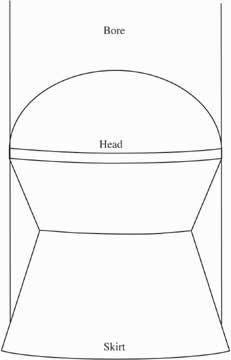by B.B. Pelletier
Today’s post applies to all airgun powerplants. It comes from a question we received yesterday:
I have a question that keeps bothering me. I was hoping that you can answer it for me. With a same gun, same power plant, different barrel (i.e. Diana 350 Magnum .177 and .22) and shoots pellets of same weight (i.e. .177 15 grain and .22 15 grain). Which caliber would shoot further?
That’s a good question!
Assuming the same powerplant, will the pellets exit the muzzle at the same speed? I don’t know. In all the years I have been reading about airguns, this is an experiment that I have never seen performed. I’m not sure it CAN be performed, because a 15-grain .177 pellet will be vastly different in shape than a 15-grain .22 pellet. That introduces bias, negating the results. The .177 pellet has to be MUCH longer in order to weigh that much, whereas the .22 pellet is just a standard medium weight for that caliber.
Unless the .177 pellet is designed expressly for this experiment, I think it might have so much surface area in contact with the bore that it would be slower than the .22 – but I can’t prove it.
I can’t answer this question
I’m not sure anyone can answer this question. It’s like asking who would win a boxing match between Floyd Patterson and Mike Tyson. You can argue the outcome for years and never solve the riddle. However, I think there is another unasked question at the root of today’s question: What pellet is best suited for long-range shooting? That’s one I can take a stab at!
Long-range performance of the diabolo pellet
The pellet shape takes its name from a juggling apparatus called a diabolo. That’s dee-ab’u-low”. (It’s not diablo, which is Spanish for “devil”!) It’s the thing jugglers balance on a string attached to two stick held in their hands.

The diabolo is a type of gyroscope that is balanced on a string held in the hands. Its pinched waist gave the name to the modern wasp-waisted pellet.
Author Sam Fadala has done extensive testing, demonstrating that a round lead ball loses approximately one-half its initial velocity in the first 100 yards. Because energy is based on the SQUARE of the velocity, that means about two-thirds of the energy has been lost at the same distance. The size of the ball makes absolutely no difference, so airguns are included in this discussion. You can read all about Fadala’s testing in The Complete Blackpowder Handbook from DBI Books, Inc.
Now, diabolo (not diablo!) pellets slow down at an even greater rate than round balls because they have greater drag. So, a pellet that starts with 30 foot-pounds of energy at the muzzle may retain only 12 foot-pounds at 100 yards. That number, by the way, is representative. I have not done actual testing to ascertain the true figure. And pellets, having variations in their ballistic coefficients from brand to brand, will vary just a little. But I believe they will all perform equal to or worse than a round ball, which loses about 50 percent of its initial velocity at 100 yards.
Learn to think like a buffalo hunter
The buffalo hunters of the 1870s killed millions of buffalo with blackpowder rifles that seldom exceeded 1,400 f.p.s. at the muzzle. The ranges at which they shot buffalo were often greater than 300 yards, because they tried not to spook the herd and therefore get more animals in a single “stand.” A slow-moving bullet drops many YARDS by the time it travels that far, so the hunters learned to estimate distances very well, and they knew the trajectory of their bullets. They used ONE load of powder and ONE type of bullet, only. And that is my recommendation to all who want to hunt long range with airguns.
Quit trying to shoot your pellets flatter – it cannot be done and still retain accuracy. Instead, learn the trajectory of your most accurate pellet and practice only with it. Greater velocity is not the solution to long-range accuracy with a pellet rifle. Knowledge of the performance of your one best pellet is what you need. Stop experimenting and settle down with one pellet and one rifle. Then, and only then, will you become the long-range shot you really want to be.
To the person who posed today’s question…if it were up to me, I would choose the .22 caliber Diana 350 Magnum over the .177.
The .22 would have more front surface drag but like you said the .177 would have greater bore drag. I would say all in all it would come down to how much surface drag each pellet was displacing.
I can’t speak for .177 vs .22 from the same system but, I thought it was interesting that from a high power gun a 21.3gr .22 pellet hit about 11 inches higher than a 14.5gr 22 pellet at 100 yds. but a 28gr pellet hits about a half foot lower than the 14.5gr pellet.
Just a comment. If the round ball loses half of its velocity first 100 yard, it has lost 3/4 of its energy. Not 2/3.
I guess that stands to reason, give that energy is determined by the square of the velocity!
B.B.